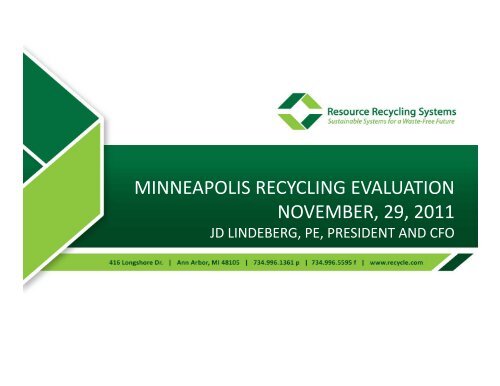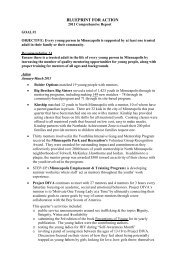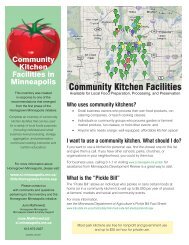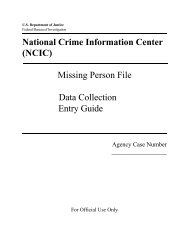minneapolis recycling evaluation november, 29, 2011 - City of ...
minneapolis recycling evaluation november, 29, 2011 - City of ...
minneapolis recycling evaluation november, 29, 2011 - City of ...
You also want an ePaper? Increase the reach of your titles
YUMPU automatically turns print PDFs into web optimized ePapers that Google loves.
MINNEAPOLIS RECYCLING EVALUATION<br />
NOVEMBER, <strong>29</strong>, <strong>2011</strong><br />
JD LINDEBERG, PE, PRESIDENT AND CFO
QUESTIONS (AND ANSWERS)<br />
• If Minneapolis switched from the current<br />
multi‐sort system to dual or single sort, what<br />
could the city expect in the areas <strong>of</strong>:<br />
1. Recycling Rate? ‐ Increase<br />
2. Residual Rate? ‐ Increase<br />
3. Net Revenue? ‐ No significant decrease<br />
4. Operations? ‐ More efficient
INFORMATION USED FOR THIS STUDY<br />
• Minneapolis<br />
– Current program and dual/single sort pilot programs<br />
• St. Paul<br />
– Converted from source separated to dual sort in 2001.<br />
• Ann Arbor<br />
– Converted from multi sort to dual sort in 1995, converted<br />
to single sort in 2009<br />
• Portland<br />
– Converted from multi sort to dual sort in 1999<br />
• Other Cities including Cincinnati, Kansas <strong>City</strong>, Toledo
NATIONAL TRENDS<br />
In 2010, the trend<br />
continued:<br />
64% <strong>of</strong> American<br />
households had<br />
access to single<br />
sort <strong>recycling</strong>
20%<br />
19%<br />
18%<br />
17%<br />
16%<br />
15%<br />
14%<br />
13%<br />
12%<br />
11%<br />
10%<br />
RECYCLING RATE<br />
<strong>City</strong> <strong>of</strong> Minneapolis Recycling Rate<br />
2005 2006 2007 2008 2009 2010<br />
Hennepin County<br />
Goal for Minneapolis<br />
is 35% by 2015
RECYCLING RATE<br />
Recycling Rate*<br />
Current MPLS 17%<br />
St. Paul 30%<br />
Ann Arbor 37%<br />
Portland 34%<br />
Kansas <strong>City</strong>^ 20%<br />
Cincinnati^ 23%<br />
* Recycling Rate calculated by<br />
dividing total recyclables by total<br />
waste (trash + recyclables),<br />
excluding yard waste<br />
^ Kansas <strong>City</strong> and Cincinnati do<br />
not collect yard waste separately
WHY ARE SOME HIGHER THAN<br />
OTHERS?<br />
• Ann Arbor, Portland<br />
– Both have weekly cart based programs<br />
– Strong education<br />
– Limits on trash setout (Portland switched to every<br />
other week trash a couple weeks ago)<br />
• Saint Paul<br />
– Weekly bin program<br />
– Strong education<br />
– Multi‐hauler system for<br />
waste
WHY ARE SOME HIGHER THAN<br />
OTHERS?<br />
• Cincinnati<br />
– Biweekly cart program just recently rolled out,<br />
likely to rise<br />
– No significant limits on trash setout<br />
• Kansas <strong>City</strong><br />
– Opt‐in <strong>recycling</strong> program<br />
– Bin only<br />
– PAYT program but no<br />
strong <strong>recycling</strong> push
COMMINGLING INCREASES<br />
CONVENIENCE<br />
• Survey results from a biweekly single sort cart pilot
RESIDUAL RATE<br />
• Residual rate is the amount <strong>of</strong> material<br />
thrown out at the <strong>recycling</strong><br />
facility<br />
– Composed <strong>of</strong>:<br />
• Non‐recyclable materials<br />
• Recyclable materials that<br />
weren’t sorted out
SINGLE AND DUAL SORT<br />
• Significant increase in system capabilities in past 5<br />
years reduce recyclable material lost during process<br />
Improved screens,<br />
optical sorters and<br />
front end metering<br />
Remove glass up<br />
front to reduce<br />
contamination<br />
More plastics are<br />
recyclable
MATERIAL RECOVERY FACILITY (MRF)<br />
17%<br />
Old Single<br />
Stream<br />
Programs<br />
10%<br />
RESIDUAL RATE<br />
7%<br />
Toledo (SS) Cincinnati<br />
(SS)<br />
4% 4%<br />
Portland (SS) Ann Arbor<br />
(SS)<br />
0.6% 0.5%<br />
St Paul (DS) Minneapolis<br />
(MS)
MARKET TRENDS<br />
• No evidence <strong>of</strong> decreased prices paid for single or dual<br />
sort material, but processing fees differ based on<br />
program type<br />
• No difficulty for facilities to move material to market<br />
– Strong demand from Asia (China/India/etc.) for all<br />
materials<br />
• Processing fees for single and dual sort MRFs range<br />
from $60 ‐ $80 per ton<br />
– Revenue above processing fee is split between MRF<br />
processor and <strong>City</strong><br />
– More cost efficient to sort material in a central location<br />
than on the curb
MARKET TRENDS (DATA)
MARKET TRENDS (DATA)<br />
Very Fast Recovery<br />
after Financial<br />
Meltdown
Average<br />
Commodity<br />
Revenue<br />
Net<br />
Payment<br />
to <strong>City</strong><br />
Current<br />
MPLS<br />
REVENUE SHARE<br />
Dual Sort<br />
Pilot<br />
Single<br />
Sort Pilot<br />
St. Paul Cincinnati Ann<br />
Arbor*<br />
$150/ton $150/ton $150/ton $150/ton $150/ton $150/ton<br />
$115/ton $30/ton $41/ton $75/ton<br />
*Note: Ann Arbor owns the MRF building and equipment<br />
Kansas <strong>City</strong> and Portland receive no revenue share<br />
Revenue above processing fee is split between MRF processor and <strong>City</strong>
Collection<br />
Cost per<br />
Ton<br />
Revenue<br />
per Ton<br />
Net Cost<br />
per Ton<br />
NET PROGRAM COSTS<br />
Current<br />
MPLS<br />
Ann Arbor St. Paul Kansas <strong>City</strong> Cincinnati Portland<br />
$233 $131 $145 $168 $148 $205<br />
$115 $75 $30 $0 $41 $0<br />
$118 $56 $115 $168 $107 $205
30% - 85%<br />
increase in<br />
recovery<br />
PROGRAM CHANGES<br />
Increase in<br />
processing<br />
fees<br />
Reduced<br />
collection<br />
costs<br />
It’s possible to switch to a<br />
commingled program without<br />
increasing <strong>recycling</strong> costs<br />
Increase in<br />
capital cost<br />
for new<br />
carts<br />
Waste Savings:<br />
Avoided tip fees<br />
& Potential route<br />
savings
POTENTIAL PROGRAM COST CHANGES<br />
Current Collection Projected Costs<br />
Collection Cost/HH/month $2.92 $1.75 ‐ $2.10<br />
Capital Cost/HH/Month $0.21 $0.77 ‐ $0.90<br />
MSW Savings ($/HH/Month) $0.24 ‐ $0.61<br />
MRF Revenue/HH/Month $1.52 $0.67 ‐ $1.35<br />
Net Cost/HH/Month $1.61 $1.26 ‐ $2.08<br />
It’s possible to switch to a<br />
commingled program without<br />
increasing <strong>recycling</strong> costs
STUDY ‐ CONCLUSIONS<br />
Current<br />
Recovery Same<br />
as St Paul<br />
Recovery Same<br />
as Portland<br />
Tons Collected 18,580 25,097 34,454<br />
Net Revenue per Ton $ 115 $ 60 $60<br />
Net Payment to <strong>City</strong> $ 2,136,700 $ 1,505,811 $ 2,067,218<br />
Avoided Tip Fees ($45/ton) $ ‐ $ 306,<strong>29</strong>2 $ 439,769<br />
Net Revenue $ 2,136,700 $ 1,812,104 $ 2,506,987<br />
Collection Savings ?? ??
STUDY ‐ CONCLUSIONS<br />
• Peer cities programs have moved away from<br />
source separation<br />
• Material diversion is almost double in peer<br />
communities with dual or single‐sort<br />
• Markets for materials accept residue as cost <strong>of</strong><br />
doing business<br />
• Single sort programs can produce high<br />
material quality with good education program
WHAT CAN MINNEAPOLIS EXPECT<br />
Variable New Minneapolis Recycling Program<br />
Collections Increase citywide <strong>recycling</strong> weight by 20% to 40%<br />
Average Commodity Prices<br />
Similar to current program commodity prices<br />
(Market driven).<br />
Processing Costs Estimate $60 to $80 per ton.<br />
Residual Rates 1% to 4%<br />
Avoided Tipping Fees Saves the city $45/ton<br />
Operational Costs<br />
More efficient. Details <strong>of</strong> operational changes need<br />
further investigation.
WHAT CAN MINNEAPOLIS EXPECT<br />
• A new <strong>recycling</strong> program will increase the<br />
amount <strong>of</strong> waste recycled in Minneapolis.<br />
• Depending on its features (one sort or two<br />
sort) and accomplishments, a new <strong>recycling</strong><br />
program will either cost slightly less or<br />
somewhat more than the current program.<br />
• The overall cost per ton recovered will be<br />
reduced.
QUESTIONS<br />
• Thanks for your Attention!<br />
• JD Lindeberg, PE RRS President and CFO<br />
734‐646‐3303<br />
jdl@recycle.com







